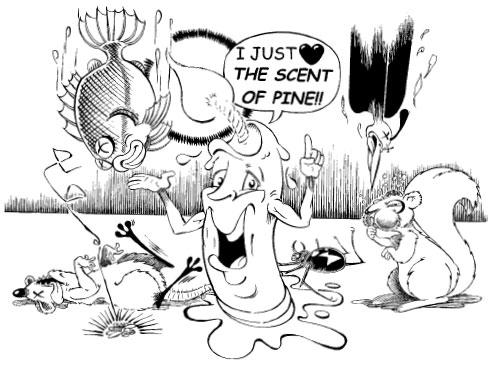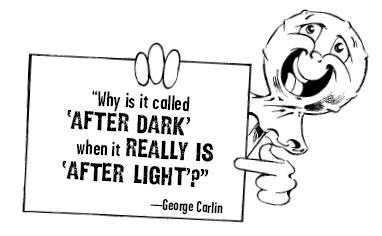When All Hell Breaks Loose (70 page)
Read When All Hell Breaks Loose Online
Authors: Cody Lundin
Making Sense of Scented Candles

Our sense of smell is one of our most powerful senses, and fragrance experts say that some smells can have a deep affect on people's psyches. Candles are available in a seemingly endless variety of fragrances from blooming flowers to baked goods to apple cider to pine trees. Believe it or not, according to data from the National Candle Association, the most important factor that people look for when buying candles is their fragrance. While scented candles may help folks feel relaxed, refreshed, and calm, they can also antagonize allergies and tempers and be a real turn-off, especially in tight quarters or locations with minimal airflow. Some environmentally sensitive people that I know can't even be in the same building with scented candles as the smell makes them sick. While you may dig the aromatherapy effects of scented candles, Cousin Jack might not. Play it safe and reserve burning the scented candles for use in the outhouse or the next holiday dinner.
BURNIN' DOWN THE HOUSE
According to data from the USFA's National Fire Incident Reporting System and the National Fire Protection Agency, most candle fires (44.5 percent) occur in the bedroom (wink, wink!); followed by the living room, family room, or den (18.6 percent); the bathroom (11.4 percent); and the kitchen (7.2 percent). The most common materials to go up in flames were mattresses or bedding (12.8 percent); cabinetry (10.1 percent); and curtains, blinds, or drapes (8.4 percent).
Forty percent of the fires occurred because candles were left unattended, abandoned, or inadequately controlled. Nearly 20 percent occurred because a combustible item was too close to the candle. The following figures represent the leading causes for residential candle fire incidents:
Candle left alone—19.3 percent
Candle too close to combustibles—19.1 percent
Candle misused—11.4 percent
Inadequate control of flame—10.2 percent
Out-of-control kids—8.7 percent
Abandoned material—7.4 percent
Falling asleep—4.5 percent
Homemade Primitive Candles
Fat or Oil Lamps

One of the most well-known indigenous candles is the Inuit fat lamp or
kudlick
. Fat lamps or oil lamps, in one form or other, have been around for thousands of years cross-culturally. All indigenous peoples needed to make a fat lamp was a container, fat or oil, and a wick. In ancient Greece and Rome, lamps were fueled by olive oil; in India, ghee was used; and in ancient Persia they used petroleum that was freely oozing from the ground. Olive oil lamps continued to be used in countries around the Mediterranean Sea up until the nineteenth century. A recent experiment in the metrology laboratories of Kodak-Pathe, France, used modern replicas of Paleolithic fat-burning lamps to investigate how much light they put off. It was found that although the lamps lacked the light intensity of a candle, they were still good enough to illuminate the way for navigating through a cave or to light up fine work such as creating a cave painting when placed close to the work. Recent experiments of my own using primitive lamps in various teepees, wickiups, and wall tents have shown the same results.
You can make your own fat lamp using everyday household items following Robbie Rubbish's instructions. Any sort of noncombustible container can be used such as clean metal cans, bottles, or clay jars, along with an assortment of different fats and oils, such as olive oil, corn oil, vegetable oil, vegetable shortening, liquid paraffin, and others. Even bacon grease and lard will work but must be cleaned first of debris in order to burn reliably. Good wicks, through capillary action, "wick" heated liquid fuel up their length and convey it to the free-burning end without being consumed too quickly. Serviceable wicks can be made from an assortment of items from jute or cotton string to pieces of rag or clothing. Some mosses, lichen, grasses, and fibrous plants, such as juniper bark and dogbane, will work as they are or processed into cordage. Even twisted-up toilet paper or paper towels will work. The amount of light put out by the fat or oil lamp is determined by the quality of the fuel and the length of the wick. More wick usually means more light, at the expense of burning more fuel. The type of fuel, what the wick is made from, and how the wick is adjusted will determine the amount of blackish smoke and smell coming from your lamp, so go for the cleanest-burning fuels possible. In my oil lamps, I use commercially available braided "glass" wicks, as they smoke the least and last for an eternity. Even so, playing four hours of Monopoly around a couple of oil lamps will cause you to have black boogers the next time you blow your nose. All orange and yellow flames produce harmful carbon monoxide gas so use caution.
Pitch Wood Candles
Some earthy-yuppie catalog retailers sell resin-saturated wood by the name of "fat wood," or pitch wood. If you live in or around evergreen woods, you can gather it by the ton with no cost other than your time. Pitch wood refers to conifer trees in which, for whatever reason (usually it's because the tree has died), their highly combustible sap has been condensed into focused areas. It's easy to distinguish from regular wood as it's a lot heavier and denser. In an area where an evergreen has died and mostly rotted away, pitch wood might be the only pieces of wood left, as it's fairly rot resistant. Take a knife to a piece of pitch wood and carve off a bit of the outer layer and you'll see a honey color that will smell strongly of sap. Pitch wood burns like crazy. It can be split and made into emergency candles for lighting or used to help ignite and burn wet fuel.
To make a candle, find a piece of pitch wood in which the grain runs from end to end. It can be a piece as big around as a pencil or your finger or larger, and six to twelve inches long or longer. Make a split on one of the ends about an inch deep. Split it the other way as well so that the end has four distinct "prongs." I wedge a couple of tiny pieces of wood into the splits to keep the prongs away from each other. This allows oxygen to infiltrate your "candle." Unlike a blob of pine pitch, which will burn in a chaotic, bubbling mess, the grain in the pitch wood acts like the wick of a candle, helping to stabilize the flame for controlled burning. Pitch wood candles take some fussing around and put off an intense black smoke, but they may have applications for your family if you're down and out on the back forty.
Lovable Lanterns
In general, a lantern is a portable lighting device that's used to illuminate large areas. There are many types to choose from. Some lanterns are used for decoration, others for general outdoor camping, and others are safe enough to bring into the house. Most of these lanterns are fuel-based of one type or another, whether kerosene, white gas, propane, or wax. CAUTION! All fuel-burning lanterns can be hazardous, and the dangers include burns, the potential of fire, dealing with flammable and toxic fuels, and carbon monoxide poisoning. If you have kids or pets, think twice about using fuel-burning means of illumination.
Candle Lanterns
Candle lanterns have been around for a very long time and consist of some sort of glass container, which lets the light through but protects the candle flame from the wind. Centuries ago, the Chinese captured fireflies and added them to transparent containers for cool but short-lived lanterns. In the past two decades, candle lanterns have become vogue in the camping and backpacking scene by companies who have designed lightweight, telescoping lanterns for easy packing. You can easily make your own by putting a candle inside a glass jar and anchoring it in sand or dirt. Wire can be wrapped around the top of the jar or around the jar itself so the homemade lantern can be suspended where convenient. Caution should be used with ANY direct flame method of lighting your house, so reread the previous candle safety tips.
Kerosene Lanterns and Lamps
Flat-wicked kerosene lanterns, sometimes called hurricane lamps, were commonly used since the late 1800s for lighting homes, barns, and outhouses, as well as horse-drawn carriages, railroad cars, and early automobiles. They were also used as an early method of navigation and signaling on both land and sea and had interchangeable colored globes of glass to signify different needs and intentions. They are still available at discount and camping stores. While these lanterns are cheap and durable, they provide little light and are not suited for reading. They also require a periodic trimming of their wick and regular cleaning of soot build-up from the inside of the glass chimney.
These lanterns were originally designed as a more portable and durable version of the kerosene lamp. Cheaper kerosene lanterns should not be brought into an airtight house, as they stink (especially when using poor grades of kerosene), can be dangerous if tipped over, and are more likely to cause carbon monoxide poisoning than more expensive and better-burning kerosene lamps.
Just a few generations ago,
kerosene lamps
were the mainstay of lighting up almost everyone's life. My grandparents grew up with them and have passed a few on down to me. The king of kerosene lamp makers was The Mantle Lamp Company of America, which was founded in Chicago, Illinois, in 1908. The company changed its name in 1949 to Aladdin Industries. In 1999, a group of lamp collectors called the Aladdin Knights purchased part of the company and renamed it the Aladdin Mantle Lamp Company.
Aladdin created some absolutely gorgeous kerosene lamps for the home that have modern lamp collectors drooling. Aladdin also trashed the poorly performing flat-type wick and developed a specialized cylindrical wick with a central airflow tube that works awesomely with the high and uniform heating demands of mantle-type lighting. Mantle-type lanterns use a woven, ceramic-impregnated gas mantle to accept and reradiate heat as visible light from a flame. The mantle itself doesn't burn, although the cloth matrix carrying the ceramic must be "burned" with a match prior to first using a new mantle. When heated by the flame, the mantle glows incandescently, and some have a comparable light output of a standard 60-watt light bulb or more! To stabilize the airflow and to protect against the high temperatures that are created, a cylindrical glass shield called a "globe" or chimney is placed around the mantle.

Conforming to modern times, Aladdin later went on to manufacture electrical lamps as well. Even today, Aladdin lamps enjoy a cult following and it shouldn't be hard to buy obscure parts for your lamp with a little searching on the Internet. While kerosene lamps rate high on the nostalgic cool meter, and they do work well, they can be quite complex to operate (and expensive to buy) and must have an owner that doesn't mind fiddling with this and that to get the best results. Unless you already have experience with this type of lighting, leave it to the collectors for use during an emergency.